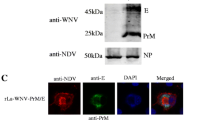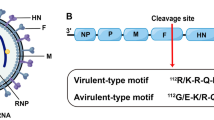Abstract
Marek’s disease virus (MDV) is an important oncogenic poultry pathogen that can generally be controlled by vaccination. However, MDV infections still occur occasionally on vaccinated farms, possibly due to genetic variation among MDV strains or management-related issues. In this study, a novel MDV strain, designated LZ1309, was isolated from a poultry flock that had been vaccinated with the HVT and CVI988 vaccine strains. Animal experiments showed that LZ1309 infection led to high morbidity (100%) and mortality (90%). Moreover, existing vaccines provided only partial protection against LZ1309, with protection rates of 68.4%, 85%, and 90% for HVT, CVI988, and HVT plus CVI988, respectively. This study demonstrates the presence of a more virulent strain of MDV in vaccinated chickens in China that poses a new potential threat to poultry farms. In future studies, the development of new treatment strategies should be of high priority.






Similar content being viewed by others
References
Osterrieder N, Kamil JP, Schumacher D, Tischer BK, Trapp S (2006) Marek’s disease virus: from miasma to model. Nat Rev Microbiol 4:283–294
Witter RL, Calnek BW, Buscaglia C, Gimeno IM, Schat KA (2005) Classification of Marek’s disease viruses according to pathotype: philosophy and methodology. Avian Pathol 34:75–90
Nair V (2004) Successful control of Marek’s disease by vaccination. Dev Biol (Basel) 119:147–154
Witter RL (2001) Protective efficacy of Marek’s disease vaccines. Curr Top Microbiol Immunol 255:57–90
Schat KA (2016) History of the first-generation Marek’s disease vaccines: the science and little-known facts. Avian Dis 60:715–724
Atkins KE, Read AF, Savill NJ, Renz KG, Islam AF, Walkden-Brown SW, Woolhouse ME (2013) Vaccination and reduced cohort duration can drive virulence evolution: Marek’s disease virus and industrialized agriculture. Evolution 67:851–860
Read AF, Baigent SJ, Powers C, Kgosana LB, Blackwell L, Smith LP, Kennedy DA, Walkden-Brown SW, Nair VK (2015) Imperfect vaccination can enhance the transmission of highly virulent pathogens. Plos Biol 13:1–18
Boodhoo N, Gurung A, Sharif S, Behboudi S (2016) Marek’s disease in chickens: a review with focus on immunology. Vet Res 47:119–138
Lopez-Osorio S, Piedrahita D, Espinal-Restrepo MA, Ramirez-Nieto GC, Nair V, Williams SM, Baigent S, Ventura-Polite C, Aranzazu-Taborda DA, Chaparro-Gutierrez JJ (2017) Molecular characterization of Marek’s disease virus in a poultry layer farm from Colombia. Poult Sci 96:1598–1608
Raquel H, Dennis TB (2010) Growth and maintenance of chick embryo fibroblasts (CEF). Curr Protoc Microbiol Appendix 4:4I
Landman WJM, Verschuren SBE (2003) Titration of Marek’s disease cell-associated vaccine virus (CVI 988) of reconstituted vaccine and vaccine ampoules from Dutch hatcheries. Avian Dis 47(4):1458–1465
Silva RF (1992) Differentiation of pathogenic and non-pathogenic serotype 1 Marek’s disease viruses (MDVs) by the polymerase chain reaction amplification of the tandem direct repeats within the MDV genome. Avian Dis 36:521–528
Chacon RD, Astolfi-Ferreira CS, Guimaraes MB, Torres LN, De la Torre DI, Sa LRM, Piantino Ferreira AJ (2019) Detection and molecular characterization of a natural coinfection of Marek’s disease virus and reticuloendotheliosis virus in Brazilian backyard chicken flock. Vet Sci 6:1–14
Li Y, Wang Y, Fang L, Fu J, Cui S, Zhao Y, Cui Z, Chang S, Zhao P (2016) Genomic analysis of the chicken infectious Anemia virus in a specific pathogen-free chicken population in China. Biomed Res Int 2016:1–5
Sithara R, Stephen WW, Katrin GR, Fakhrul Islam AFM (2016) Protection provided by Rispens CVI988 vaccine against Marek’s disease virus isolates of different pathotypes and early prediction of vaccine take and MD outcome. Avian Pathol 45(1):26–37
Yu ZH, Teng M, Luo J, Wang XW, Ding K, Yu LL, Su JW, Chi JQ, Zhao P, Hu B, Zhang GP, Liu JX (2013) Molecular characteristics and evolutionary analysis of field Marek’s disease virus prevalent in vaccinated chicken flocks in recent years in China. Virus Genes 47:282–291
Dunn JR, Black Pyrkosz A, Steep A, Cheng HH (2019) Identification of Marek’s disease virus genes associated with virulence of US strains. J Gen Virol 100:1132–1139
Murata S, Machida Y, Isezaki M, Maekawa N, Okagawa T, Konnai S, Ohashi K (2020) Genetic characterization of a Marek’s disease virus strain isolated in Japan. Virol J 17:186–199
Ozan E, Muftuoglu B, Sahindokuyucu I, Kurucay HN, Inal S, Kuruca N, Elhag AE, Karaca E, Tamer C, Gumusova S, Albayrak H, Barry G, Gulbahar MY, Yazici Z (2021) Marek’s disease virus in vaccinated poultry flocks in Turkey: its first isolation with molecular characterization. Arch Virol 166:559–569
Wajid SJ, Walkden-Brown SW, Vanselow BA, Islam AF, Renz KG (2015) In vivo characterisation of two Australian isolates of Marek’s disease virus including pathology, viral load and neuropathotyping based on clinical signs. Aust Vet J 93:240–247
Murata S, Okada T, Kano R, Hayashi Y, Hashiguchi T, Onuma M, Konnai S, Ohashi K (2011) Analysis of transcriptional activities of the Meq proteins present in highly virulent Marek’s disease virus strains, RB1B and Md5. Virus Genes 43:66–71
Witter RL (1997) Increased virulence of Marek’s disease virus field isolates. Avian Dis 41:149–163
Zhenhua G, Lijuan Z, Jianlin W, Linlin C, Hu S, Zhiliang W, Hongchao M (2013) Isolation and analysis of a very virulent Marek’s disease virus strain in China. Virol J 10:155–163
Sun GR, Zhang YP, Lv HC, Zhou LY, Cui HY, Gao YL, Qi XL, Wang YQ, Li K, Gao L, Pan Q, Wang XM, Liu CJ (2017) A Chinese variant Marek’s disease virus strain with divergence between virulence and vaccine resistance. Viruses 9:1–11
Abd-Ellatieff HA, Abou Rawash AA, Ellakany HF, Goda WM, Suzuki T, Yanai T (2018) Molecular characterization and phylogenetic analysis of a virulent Marek’s disease virus field strain in broiler chickens in Japan. Avian Pathol 47:47–57
Kozdrun W, Stys-Fijol N, Czekaj H, Piekarska K, Niczyporuk JS, Stolarek A (2020) Occurrence of Marek’s disease in Poland on the basis of diagnostic Examination in 2015–2018. J Vet Res 64:503–507
Shi M, Li M, Wang P, Wang W, Li H, Gao Y, Lin L, Huang T, Wei P (2021) An outbreak in three-yellow chickens with clinical tumors of high mortality caused by the coinfection of reticuloendotheliosis virus and Marek’s disease virus: a speculated reticuloendotheliosis virus contamination plays an important role in the case. Poult Sci 100:19–25
Boots M (2015) The need for evolutionarily rational disease interventions: vaccination can select for higher virulence. Plos Biol 13:1–6
Acknowledgements
This study was funded by the Educational Department of Jiangxi Province (Grant no. GJJ190568).
Author information
Authors and Affiliations
Contributions
HL and ZG contributed equally to this work. All authors reviewed and improved the manuscript.
Corresponding author
Ethics declarations
Conflict of interest
The authors declare no conflict of interest.
Additional information
Handling Editor: Ana Cristina Bratanich.
Publisher's Note
Springer Nature remains neutral with regard to jurisdictional claims in published maps and institutional affiliations.
Rights and permissions
About this article
Cite this article
Li, H., Ge, Z., Luo, Q. et al. A highly pathogenic Marek’s disease virus isolate from chickens immunized with a bivalent vaccine in China. Arch Virol 167, 861–870 (2022). https://doi.org/10.1007/s00705-021-05355-w
Received:
Accepted:
Published:
Issue Date:
DOI: https://doi.org/10.1007/s00705-021-05355-w




